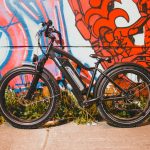Fat tire bikes, with their massively wide tires, look very different from traditional mountain bikes. But do those plus-sized tires actually help you balance better on the trails? The answer depends on a few key factors like terrain, body positioning, and bike handling skills. Let’s explore this balance question and see if a fat bike provides any real advantages.
How Fat Bike Tires Affect Balance
At first glance, you’d think the broad tires would help stabilize you more versus narrow conventional tires. And to some degree, this is true – fat bike tires provide a larger “tripod” of rubber contacting the ground compared to standard mountain bike tires. The bigger overall footprint generates more traction and side-to-side stability when climbing steep grades or riding across uneven surfaces.
However, those ultra-wide tires also move the bike’s contact patches further apart. This increased width means you may feel a bit more tippy or unstable when leaned over at extreme angles. So fat bikes tend to feel quite planted and confidence-inspiring for straight-line riding, but can require some extra body positioning refinement when tipping into turns.
Balance on Different Trail Surfaces
Where fat tire bikes truly excel for balance is riding over loose, soft, or uneven terrain. Their massive tires float across sandy areas, snow, mud, and bumpy trails far more easily than regular knobbies, minimizing bouncing and deflection that could upset your stance and balance. Fat bikes simply plow right through it all.
On smoother hardpack trails or tame routes, however, fat bikes don’t offer much added balance advantage compared to a plus-sized or regular mountain bike tire. You may even notice the hefty rotating weight of fat tires requiring more sustained pedal inputs to overcome inertia compared to lighter setups. This can potentially work against optimal overall balance feel.
Body Position and Centered Weight
When riding any mountain bike, keeping your body weight centered over the wheels and tires helps maximize stability and balance through rough sections. Because fat bike tires sit wider apart than average, riders need to consciously work on centering their body laterally while maintaining their normal fore/aft attack position.
With practice, fat bike pilots adapt a slightly wider overall stance that moves their weight centered across that broad footprint. They must be intentional about shifting weight between inside/outside wheels when initiating corners to avoid the tippy sensation from all that extra rotational mass way out beyond the frame. Proper countersteering and looking through turns becomes essential on fat bikes to maintain stability.
Once you master that wider, centralized positioning, the massive tires roll over obstacles and holes that could easily buck a smaller tire, helping sustain balance on tricky terrain. But lazy riders who let their balance positioning get sloppy will likely struggle to prevent wobbling and feeling unstable at times.
Balance at Different Speeds
At lower speeds where bike control becomes more deliberate, fat tires provide significant balance advantages for technical riding. Slow-speed maneuvers like log overs, rock gardens, stair steps, and other precarious situations become easier on a fat bike versus standard tires. The width and floatation distributes weight across iffy terrain features so you essentially stick and roll right over them instead of deflecting or bouncing off-line.
As speeds increase, fat tires reveal mixed balancing advantages. The rotating mass of those heavy tires creates serious gyroscopic stability helping you laser down rough descents when leaned over at speed. But make hard direction changes, and that same momentum can fight back against your balancing inputs until you get accustomed to feeling the heft.
So fat bikes shine for slower, deliberate balance situations versus quick, twitchy handling moves. They feel ultra-planted at higher speeds but require proactive line choices and body adjustments to achieve precision carving balance.
Ergonomics and Fit Factors
To thoroughly balance a fat bike easily, high volume tires can impact your position and bike fit in ways that influence stability. The extreme width may force a wider stance and position changes for some riders compared to their standard setups. This could require compensation with stem length, bar width, or saddle offset tweaks to achieve proper positioning over the wheels for optimal stability.
The big tires can also decrease wind-up in the bike frame itself versus skinny tires that allow more chassis flex under hard pedal inputs. More rigidity and connection to the ground tend to increase secure, locked-in feelings. But those same rider positioning changes impact your leverage on the bike, altering control inputs you feed back to the chassis versus a familiar standard bike fit.
Overall, the ergonomic factors around fat bike tire width and positioning changes can enhance or detract from rider confidence depending on whether you master those fit cues or simply try bulldozing your standard technique onto a radically different chassis design.
Do You Need a New Balance Skillset?
In many ways, balancing on fat tire bikes draws upon the same core skills and techniques required on any mountain bike, just exaggerated by the extreme tire widths involved. You still need to maintain centered body positioning, shift your hips and look through turns, use countersteering inputs, and manage momentum. But instead of subtle weight shifts, foot positions, and inputs, fat bikes demand exaggerated techniques like an ultra-wide stance and tons of intentional pedal timing to maneuver efficiently.
So for many riders, fat biking requires going back to balance basics to revisit those fundamentals we can often take for granted on more mainstream bikes. It forces you to overemphasize balance cues like looking ahead, attack positioning, preloading, and whole-body movement coordination. You can’t just rely on subtle shifts anymore – proactive aggression and deliberate skills execution become essential.
In that way, fat bikes provide challenging teaching environments to enhance existing balance talents while magnifying any bad habits or sloppy technique flaws you may have developed. Using that hyper-balanced foundation you establish on a fat bike can make you an even more capable, balanced rider when jumping back onto a regular mountain bike. So approached properly, fat biking delivers a crucial balance skillset upgrade.
Fat Bikes Open New Terrain Possibilities
While requiring focused balance skills, fat bikes reward mastery by granting access to more adventurous terrain than traditional setups ever could. Whether it’s floating across snow fields, cruising sandy desert washes, or taming muddy bog trails, fat bikes empower riders to always stay balanced thanks to their extreme floatation and traction.
Their massive footprints open up vast new playgrounds that other wheeled vehicles couldn’t dream of navigating. You can ride whenever and wherever you desire with supreme stability and confidence. So the balance proposition isn’t just optimizing one skillset, but expanding riding potential exponentially. Master the unique techniques of staying centered and controlled across those huge tires, and entire new trail possibilities become yours for the riding.
For progressing mountain bikers always looking to challenge themselves with new skills and techniques, fat bikes deliver an invaluable balance training tool. Their outrageous tires unearth fundamental stability flaws while also providing the ultimate terrain to raise your balance abilities to pro levels. What initially feels abnormal becomes advantageous with persistence and discipline. Those who invest the requisite practice in positioning and mental focus emerge as true balance masters capable of riding any rig in any conditions. Fat bikes don’t necessarily make it easier to balance overall, but they certainly provide the means to advance your balancing talents to impressive new heights.






